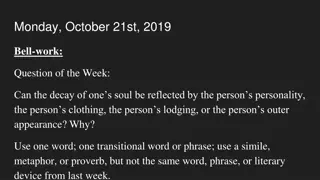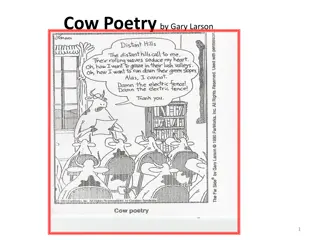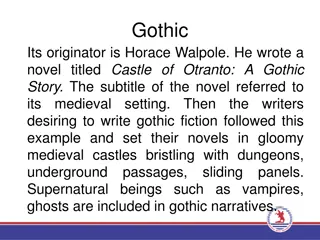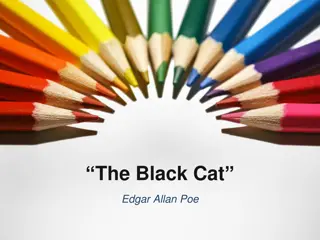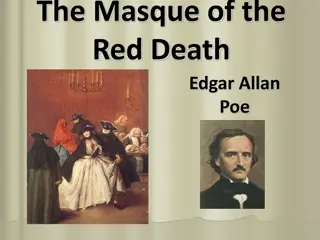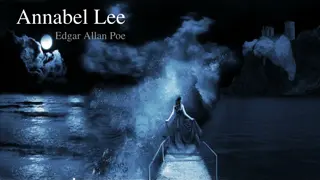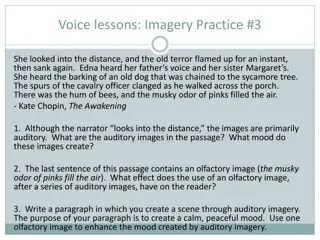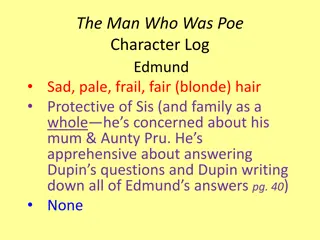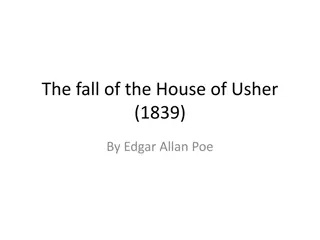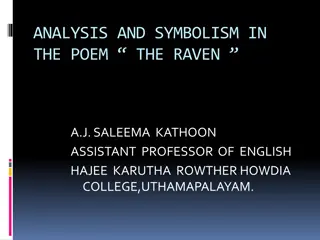Analysis of 'The Black Cat' by Edgar Allan Poe
The narrator in "The Black Cat" by Edgar Allan Poe introduces a chilling tale, setting the stage with details from his past. His childhood love of animals contrasts with his darkening mood and violent actions as an adult, particularly towards his beloved pet cat, Pluto. The story foreshadows horrors to come and explores themes of madness, supernatural elements, and domestic terror in classic Gothic literature style.
Download Presentation

Please find below an Image/Link to download the presentation.
The content on the website is provided AS IS for your information and personal use only. It may not be sold, licensed, or shared on other websites without obtaining consent from the author.If you encounter any issues during the download, it is possible that the publisher has removed the file from their server.
You are allowed to download the files provided on this website for personal or commercial use, subject to the condition that they are used lawfully. All files are the property of their respective owners.
The content on the website is provided AS IS for your information and personal use only. It may not be sold, licensed, or shared on other websites without obtaining consent from the author.
E N D
Presentation Transcript
THE BLACK CAT Edgar Allan Poe
SUMMARY SUMMARY ANALYSIS & THEMES ANALYSIS & THEMES http://www.litcharts.com/lit/poe-s-stories/the-black-cat
The narrator The narrator begins by saying that we probably won t believe what he is about to tell us. Poe uses this foreshadowing foreshadowing message to increase the sense of horror for what is to follow. But he assures us that he is not mad, and because he is about to die the next day, he wants to recount to us these household events that have caused so much terror. We already know that the narrator is on the brink of death, so the fact that the events are domestic and logical makes them even more real and horrific. He suspects that to some people, the events will seem commonplace, and their horror will be explained away with logic and science. Horror and the mundane household often come together like this in Gothic Gothic literature.
The narrator The narrator tells us of his boyhood, which was easy. The set-up of the story is nice and friendly. He had a particular love of animals and had a lot of pets and this love only increased into adulthood. The narrator s childhood sounds loving and the description of his love of animals paints a picture of a kind household, full of life. He thinks there is something in the loyalty and unselfishness of a dog that you can t get from a man. But because of the introduction, we know to be suspicious of this happy family scene. But the narrator did marry, and was lucky to find a wife a wife who appreciated his love of pets, and filled their house with a host of them, including a black cat a black cat.
This cat This cat was unusually large and intelligent. The narrator zooms in on the cat, Pluto Pluto. The narrator The narrator remembers how his wife used to talk about the superstition that black cats are all witches in disguise, but he assures us that this is unimportant to the story. He just remembers the detail. Though he assures us that his wife s superstitions are unimportant, the mention of them increases the sense of foreboding we already have for the titular black cat. Anyway, the cat s name was Pluto became a favorite of the narrator, following him everywhere. This special bond lasted several years. Pluto and
Meanwhile, though, the narrator became progressively worse. the narrator s mood Note how the act of violence is particularly directed at the symbolic symbolic eye, which Poe often uses to show the supernatural spirit or soul. He drank a lot and suffered from bouts of very bad temper, in which he even lost patience with the animals, and even with Pluto Pluto. But there is also another symbolic play here the weapon that the narrator uses is a quill pen, a writing tool, suggesting both the power and the violence that Poe feels towards the written word. symbolic act at One night, drunk, the narrator returned home, and imagined that Pluto avoiding him. Pluto was This sent him into a fit of rage, and, he is ashamed to write it, he attacked the cat and gouged out one of his eyes a quill pen. eyes with
In the morning, the narrator about the cruel act. The cat healed, but he now knew to avoid the narrator and their bond was lost. the narrator felt horrible The cat s eye socket The narrator is tormented by his own mind. It is not the cat s behavior that provokes his feeling of perverseness, it is his own disordered mental state. At first, this loss saddens the narrator but that feeling of regret gives way to anger and perverseness. He explains this word, perverse. It is a natural phenomenon in human beings, to do the thing that one knows is wrong just because it is wrong. This is an interesting take on the traditional Gothic Gothic genre: adding psychological explanations to the mix, such as the description of perversity, creates the opportunity for the reader to sympathize with the narrator, that isn't traditionally a feature of Gothic tales of past eras. It is this phenomenon that the narrator uses to explain his attack on the animal, and in the spirit of perverseness, he also commits a further act, and hangs the cat from a tree. He cried as he did it. He knows that this sin places him beyond the reach of mercy.
That very night, the narrator wife wife were awoken by the sound of flames. The house was on fire. They escaped but they saw all their possessions go up in smoke. the narrator and his his Poe plays with the idea of the power of a disturbed mind. The fire is such a violent coincidence that it seems to have been caused by some supernatural power: like the narrator s rage, or perhaps the cat itself. The narrator resigned himself to despair. He says that he does not try to prove a series of causes and effects but that he must relate a chain of facts. The coincidences continue as the outline of the cat appears in the only piece of the building not destroyed by the flames. He went back to the house the day after the fire and sees that all the walls have caved in except for one. It is the part of wall above the head of the bed, and now has a crowd of people around it. Going closer, the narrator realizes that within the wall, there is a shape in relief, of the murdered cat It is impossible to separate the disturbed vision of the narrator and the reality, because we know his mind is guiltily obsessed with the image of the cat. cat.
The narrator The narrator tries to logically explain how it could have happened. The battle in the narrator s mind between delusion and reality rages at this point. The cat The cat must have been thrown into the window when people saw the flames and gotten stuck to the recently plastered wall and been preserved there by the compression of the other walls and the substance of the plaster. He tries desperately to explain what he sees with rational thought, but his mind is already infected with superstition and his explanations begin to sound far-fetched and somewhat insane. But though the narrator believes he has explained the incident, he still gets terribly paranoid about seeing the vision again. He gets an urge to find a replacement animal.
One day, in a den of disrepute, the narrator narrator suddenly spots a cat barrel of alcohol he s been staring at. the The den setting is filled with alcohol and other substances that provoke illusions and hallucinations. a cat atop a The cat is large and looks almost exactly like Pluto apart from a white patch on its breast. By putting the narrator in this setting, Poe introduces another level of mistrust in our intimacy with him. The narrator starts petting it and finds it very responsive to his touch. Soon, the cat is very attached to the narrator and won t let him leave without him. How far can the narrator be trusted, when the arrival of Pluto s double is a product of these mind-altering drugs and dark, shady atmosphere? He takes it home, and soon the cat becomes a favorite of the narrator s wife, but, much to his surprise, the narrator finds a loathing growing within himself for the animal s unwavering affection.
The narrator The narrator starts to avoid the creature creature, partly out of this hatred but also from shame at the way he had treated his last cat. the Poe brings out his doppelganger again. The features of this new cat coincidentally make him an exact replica of the murdered Pluto. doppelganger technique He also hates a particular coincidental feature of the cat: that it too only has one eye, though this only endears the cat to his wife wife. Now this animal presents the narrator with a bigger challenge a supernatural (or possibly imaginary) rival is much more difficult to get rid of than a real one. As the narrator s loathing for the cat increases, so does the cat s affection and it springs up on the narrator unawares, looking to be petted, attaching itself with its claws. The narrator now battles with his own delusions as well as his violent moods. The narrator, at these moments, wishes he could destroy the animal, but stops himself because of the traumatic memory of Pluto but mostly because of his dread of the new cat.
The narrator The narrator tries to explain that this dread is not because of the apparent evil of the beast, but of the strange transformation of the patch of white on the cat the cat s breast into the shape of a gallows gallows it is merely a cat, yet it is his most haunting image, and has caused him somehow to be writing from this felon s cell. The narrator s turn of phrase in this passage is illuminating. By comparing himself to a high God, and therefore superior to other animals, he confesses his delusions of grandeur. He believes that the world is against him and a lot of the visions that we see appear before him, the doppelganger doppelganger animal, the gallows, the cat in the wall, can all be attributed to this inflated sense of importance. The image of the gallows narrator. gallows terrifies the He mourns that such a beast can get the better of a man like him, made in the image of a High God. Now he can get no rest, because the cat is all over him in the day time and the nights are filled with bad dreams.
In this state of permanent torture, all the goodness that the narrator the narrator had in his heart has disappeared. From the first attack on Pluto, the narrator s evil deeds multiply horrifically, each one breeding the next. His evil instincts take over, and even his wife is feeling his fury. All trace of remorse is gone. Now the narrator cold-bloodedly focuses on concealing the body of his wife, without any sign of grief or of ever having cared for her. One day, they go to visit their old house on an errand, and when the narrator sees the new cat the new cat has followed him he swings an axe at it, but his wife wife stops his arm. his Poe uses the domestic environment to amplify the horror just as the narrator warned at the beginning of the story, the household is now home to murder. In a rage, he strikes his wife in the head with the axe and kills her. His mind turns immediately to how to dispose of the body. In fact, the very walls of the family home are used to hide the bodies. He considers cutting it up, digging a grave in the cellar, but decides that the best way is to hide the body in the wall of the cellar.
The narrator's The narrator's plan works. He removes the bricks covering the fireplace, and puts the body in and covers it again. After the intense activity of the narrator s plan to hide the body in the wall, the silence in the cat s absence is strongly felt. He works hard to replace the wall and recreate the scene just as it was and in the end is satisfied that nothing is amiss. It is the quiet before the storm. We as readers know we have not heard the last of it because the narrator has not been found out (we already know that he is in prison as he writes this). Then the narrator determines to find the cat the cat so that he can at last rid himself of its presence, but he finds it absent for the first time. Though the narrator sleeps soundly, Poe keeps up the suspense for the reader. The sense of relief is extreme. The cat doesn t appear for the whole night and for the first time since its arrival, even with the murder of his wife his wife on his hands, the narrator sleeps soundly. For three more days, this bliss continues.
On the fourth day, some policemen arrive to search the property, but knowing that his stowing place is perfect, the narrator narrator is not embarrassed and leads the officers in a full tour of the house. The narrator s delusional, arrogant personality has grown out of all recognition from the animal-love we were first introduced to. the He roams about the cellar, calmly. The police are satisfied, and in his absolute glee, the narrator stops them as they depart to mention how well-built the house is and taps his cane against the brick work that hides the body. The narrator feels no fear, all remorse is gone, and he seems to delight in his crimes to the point where he desires to show them off and get credit for them. But this is his downfall. The moment he has been frantically awaiting finally comes and he receives his come-uppance. But his bravado is short lived. A horrible moan comes from the wall and turns into a shriek, half terrified, half triumphant. The narrator is suddenly faint as the police quickly uncover the corpse inside the wall. It has already started rotting, and on top of the gory figure of the narrator s wife narrator s wife, sits the cat the cat. The cat is both a supernatural rival revealing his crime, and a symbol of his tortured conscience, suddenly revealing all that he has done. the
ANALYSIS ANALYSIS The Black Cat The Black Cat
http://www.gradesaver.com/poes-short-stories/study-guide/summary-the-black-cathttp://www.gradesaver.com/poes-short-stories/study-guide/summary-the-black-cat "The Black Cat The Black Cat" bears close similarities with the story of the "The Tell begins with an unnamed narrator who has been apprehended for murder and who insists that he cannot be insane before he begins an account of a murder that he committed. The Tell- -Tale Heart Tale Heart" in that it Unlike "The Tell The Tell- -Tale Heart himself that has led him to become a murderer, although he cannot totally explain it, and we even have a potential cause for his insanity in the form of alcohol. Tale Heart," however, we have a man who is aware of the transformation in Whereas the protagonist of "The Tell were obvious and inevitable, the narrator of "The Black Cat unreasonableness, although he chooses to ignore it and succumb to the baser human emotions of perversity and hatred. The Tell- -Tale Heart Tale Heart" explains his case for murder as if his logic The Black Cat" is on some level aware of his
http://www.gradesaver.com/poes-short-stories/study-guide/summary-the-black-cathttp://www.gradesaver.com/poes-short-stories/study-guide/summary-the-black-cat One aspect of the narrator's personality that he shares with several of Poe's characters is that despite his overall lack of normal ethics and good judgment, he uses some reason and logic to avoid admissions of his mental abnormality. In particular, when he sees the image of his cat on the one remaining wall of his house after it burns down, he tries to ignore superstition and offer a reasonable, scientific explanation for its existence. Ironically, the only superstitious member of his household is his wife, who consistently shows a strong moral character despite the abuses and deterioration of her husband. Given that in "The Tell the contrast between the wife and husband in "The Black Cat between a normal mind and an unhealthy one is that the unhealthy mind uses logic to explain away what a normal mind would intuitively understand. Rather than allowing himself to use his wits to recognize the possible significance of the cat's image on the wall, he convinces himself of the scientific explanation in order to forestall thinking about his guilt. The Tell- -Tale Heart Tale Heart" the narrator's main proof of his sanity is his rational mind, The Black Cat" suggests that the difference
http://www.gradesaver.com/poes-short-stories/study-guide/summary-the-black-cathttp://www.gradesaver.com/poes-short-stories/study-guide/summary-the-black-cat The supernatural elements of "The Black Cat how much can be rationally explained, and how much is a product of the narrator's imagination. The Black Cat" leave open the question of how much is real, Pluto's possible magical significance is first noted by the wife, who states that black cats are said to be witches in disguise, although her kind treatment of Pluto indicates that she does not put much faith in this particular superstition. The narrator explicitly dismisses this viewpoint, but the superstition flavors his entire story. When he observes the image of the cat on the wall, he describes it as gigantic; he previously described Pluto as fairly large, but whether the size of the image is an expression of the paranormal or simply a product of his frightened imagination is difficult to say. Similarly, the narrator claims that the patch of fur on the cat transforms from an "indefinite splotch" to the specific image of the gallows gallows, but we have no evidence that the narrator is observing anything more than the twisting of his own mind.
http://www.gradesaver.com/poes-short-stories/study-guide/summary-the-black-cathttp://www.gradesaver.com/poes-short-stories/study-guide/summary-the-black-cat The narrator speaks specifically about the spirit of perverseness that combines with his alcohol dependence to provide the impetus for his transformation into a murderer. He is particularly careful to explain how perversity drives him to hang his cat Pluto, and at the time, he understands the evil of his crime and even feels some measure of guilt over it. The sign of his decreasing sanity comes as much from his lack of guilt over killing his wife as it does from the actual act of burying his axe in her skull. His explanation that perverseness is "one of the primitive impulses of the human heart" is called into question because of his madness, but at the same time, the story makes us wonder about the truth of his assertion. On the one hand, perverseness might seem natural to the narrator precisely because he was already prone to it, despite what he claims was his previously innocent personality. On the other hand, perhaps he is correct in that perversity exists in all men but is merely aggravated in him.
http://www.gradesaver.com/poes-short-stories/study-guide/summary-the-black-cathttp://www.gradesaver.com/poes-short-stories/study-guide/summary-the-black-cat "The Black Cat The Black Cat" is in many ways a moral tale that deals with the tension between love and hate and that warns of the dangers of alcohol, a substance to which Poe himself was addicted for much of his life. The narrator appears at first to love both his wife and his pets, but by the end of the story his fondness has turned to neglect, spite, and even hatred, particularly for Pluto and his successor. Although Poe does not provide a solid explanation for the narrator's encroaching loss of sanity, perhaps suggesting that madness might happen at any time to any person, the narrator admits the role of alcohol in his behavior. In addition, the arrival of the second cat is closely related to his alcoholism, since he first finds the cat in a seedy drinking establishment. The second cat ultimately serves as the facilitator of justice when it reveals the corpse's hiding place at the end of the tale, and its initial appearance on top of a hogshead of gin or rum emphasizes its moral purpose.
THE GOTHIC STYLE THE GOTHIC STYLE http://www.litcharts.com/lit/poe-s-stories/themes
Originating in 18th Century England, Gothic Literature movement in literary history, with a body of definite themes and symbols that has grown and changed as the genre has spread across the world and across time. Gothic Literature was an important and distinctive But some core aspects remain definitive of the Gothic style like castles, dungeons, prisons and vaults; haunting figures, ghostly and somewhat unreal; symbols and colors that suggest the gory and supernatural. Gothic style, including: Gloomy settings The Gothic style Gothic style of Poe s stories ties them all together, with their morbid, gory, suspense-filled plots and solitary, romantic settings, like the location of Prince Prospero masquerade. Prince Prospero s strange Colors black and red, and visual symbols like evil eyes and black cats, vaults and cellars, create a very recognizable gothic world, so that all Poe s stories seem to belong in one collection. Poe is famous for bringing Gothic literature psychology into their themes, making the supernatural more believable and close to home. Gothic literature into the Victorian Victorian era and incorporating
Rivals and Doppelgangers Rivals and Doppelgangers
Rivals and Doppelgangers Rivals and Doppelgangers http://www.litcharts.com/lit/poe-s-stories/themes In his stories, Poe creates a narrator faced with some kind of antagonistic person or force a rival that propels the plot of the story. In The Black Cat The Black Cat, the rival takes the form of a cat for the narrator the narrator s anxiety. a cat, which seems to have a sixth sense Often the source of the rivalry is a mystery, as in The Cask of Amontillado narrator narrator explains that a man called Fortunato Fortunato has wronged him and expresses his desire for revenge without ever explaining the nature of the original wronging. And then the punishment he exacts on Fortunato Fortunato is so extreme, that it suggests that perhaps the act tells more about how unhinged the narrator is or how unhinged his sense of rivalry has made him than it tells about the criminality of Fortunato The Cask of Amontillado, where the the Fortunato. In fact, sometimes the rivalry is free of offense entirely. In the case of The Tell Heart Heart, the narrator simply can't stand the old man the old man s vulture eye. Otherwise, the old man seems to be entirely innocent. The narrator's hatred is built up based on almost nothing. And yet it exists, and overwhelms him. The Tell- -Tale Tale
Rivals and Doppelgangers Rivals and Doppelgangers http://www.litcharts.com/lit/poe-s-stories/themes Poe s use of rivalry does not always exist between a man and some external person or force. Sometimes the rivalry is the self against the self. A doppelganger doppelganger is a German term for a figure, often paranormal, that seems to be the exact double of someone else. It is a phenomenon explored in several of Poe s stories, including the cat the cat in The Black Cat The Black Cat which seems almost to be the reincarnated in a ghostly form. But sometimes these doppelgangers paranormal doubleness. doppelgangers suggest a condition more complicated than a case of Sometimes the doppelganger that the narrator is suffering from some kind of split personality or other mental disorder. doppelganger is so similar to the teller of the story that it seems to indicate Psychological insecurity brings about some of the most frightening moments in Poe's stories, and turns the stories on their heads: everything that seemed to be caused by some paranormal force suddenly seems like it might actually be rooted in the mind.
THE BLACK CAT Questions
1. According to the narrator, why is he telling the story? 2. In the first few paragraphs, the narrator narrator gives us some information about himself. What does he stress most? 3. What characteristic did the narrator and his wife both share (at the beginning of the story)? narrator
4. What was the narrator s name? (Why is the name significant?) narrator s first cat s 5. The narrator narrator speaks of a certain disease that caused him to act horribly towards others. What was that disease? 6. What was the narrator s violence towards his cat? narrator s first act of
7. What was the second act of violence? 8. What woke the narrator sleep that night? narrator from his 9. What did he see on the wall of his room?
10. Identify a difference and similarity between the old cat and the new cat? 11. What did the narrator notice about the second cat that scared him badly? narrator gradually 12. What evil did the narrator after try to kill the second cat? narrator commit just
13. How was the narrator narrator caught? 14. Is the narrator of The Black Cat insane? Compare and contrast him with the narrator of The Tell Heart Heart. The Black Cat The Tell- -Tale Tale 15. In The Tell Cat Cat, what is the relationship between the confessions of Poe s guilty narrators and their claims to sanity and reliability? Tell- -Tale Heart Tale Heart and The Black The Black
16. How does Poe use setting as a Gothic element in The Black Cat The Black Cat and The Cask of Amontillado Cask of Amontillado? Gothic The 17. What are the similarities in The Black Cat Cat, The Tell The Tell- -Tale Heart Tale Heart, and The Cask of Amontillado of Amontillado? (Hint Hint: plot, setting, theme, characters, conflicts, etc.) The Black The Cask







